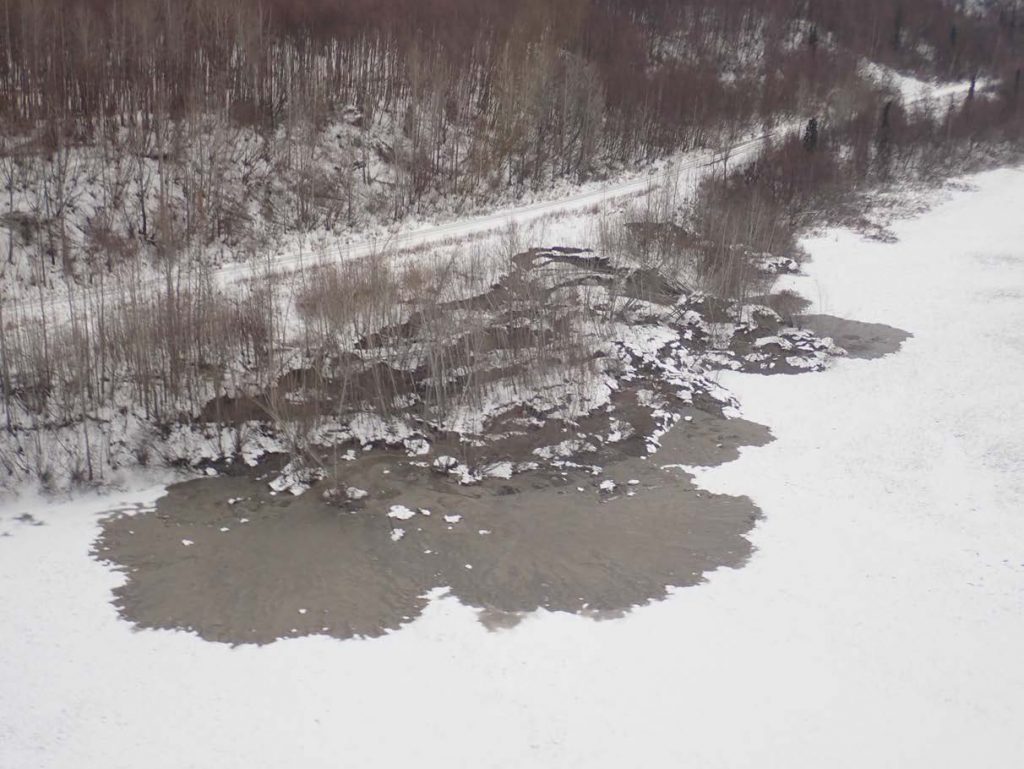26 April 2019–A day after the 30 November 2018 magnitude 7 earthquake in Anchorage, Alaska, U.S. Geological Survey scientists Robert Witter and Adrian Bender had taken to the skies. The researchers were surveying the region from a helicopter, looking for signs of ground failure from landslides to liquefaction.
As Witter will discuss at the 2019 SSA Annual Meeting, the researchers saw some of the same signs of ground failure—slumped road ramps, settled railroad grids and damaged bridges—that were already making national news. These ground failures occurred mostly in artificial fill, where unconsolidated soils and rock placed under buildings and other infrastructure were shaken by strong ground motion. But Witter and his colleagues were looking for other signs that natural materials had failed as well.
“We were more interested in what this earthquake might have done to steep slopes, the landslides they might have triggered, and to landslides that we knew about already,” Witter explained.
In particular, they wanted to know if shaking from the Anchorage earthquake had reactivated landslides from the state’s most devastating earthquake, the 1964 magnitude 9.2 Great Alaska earthquake, as well as the 1954 magnitude 6.4 Kenai Peninsula earthquake.
For the most part, these landslides stayed intact during the 2018 quake, probably because the duration of shaking during this earthquake was much shorter, the researchers concluded. Shaking went on for 20 to 40 seconds during the Anchorage earthquake, while shaking continued for four to five minutes during the 1964 earthquake.
There were some signs that the past landslides had been impacted by the 2018 earthquake, however. Witter and his colleagues checked on the 1964 Turnagain Heights landslide in Anchorage’s Earthquake Park and the Government Hill landslide, which destroyed an empty elementary school in 1964.
”What we found at both those places is along the head scarps, or the tops of the landslides, and along block boundaries that moved during these 1964 landslides new cracks had formed about a centimeter wide that extended tens of meters in length,” said Witter. “That suggested to us that these landforms were responding to the [2018] shaking, but that the shaking didn’t last long enough to reactivate them.”

The scientists did see long-run out landslides in Potter Hill in south Anchorage, near the railroad tracks. The Potter Hill landslides are “significant because they’re occurring in an area that is geologically susceptible to landslides, and where they have occurred in the past,” Witter said. Earthquake-triggered landslides destroyed the tracks in 1954 and 1964, but the 2018 landslides did not damage the rails. Using light detection and ranging (lidar) data acquired before and after the 2018 earthquake, researchers were able to calculate the volume of the new landslides.
In the tidal flats and deltaic environments along Cook Inlet and similar areas, Witter and his colleagues also documented evidence of liquefaction, including “sand volcanoes,” where unconsolidated sand and soils saturated with groundwater lose their strength after earthquake shaking, behaving more like a liquid than a solid.
These signs of liquefaction were swept away in the next high tide, and other evidence of ground failure was covered by snow a few days later, impressing upon the researchers the importance of immediate reconnaissance after an earthquake.
“We need to document the effects of earthquakes right after they happen, because the evidence sometimes can be quickly erased,” said Witter.
The data collected by Witter and his colleagues will help the USGS further develop and test its near real-time ground failure products, which are predictive maps of where landslides and liquefaction may occur after an earthquake in a particular region.
